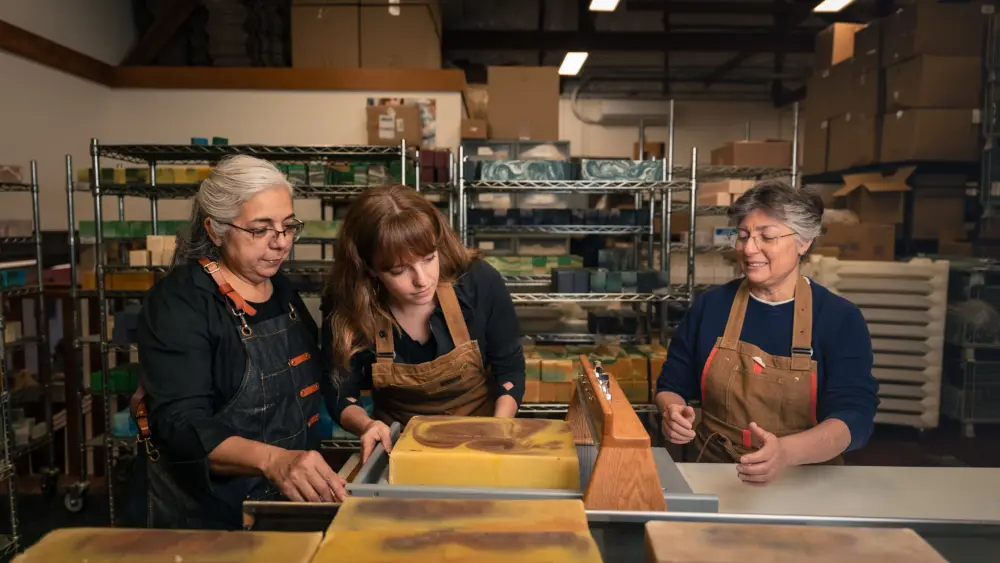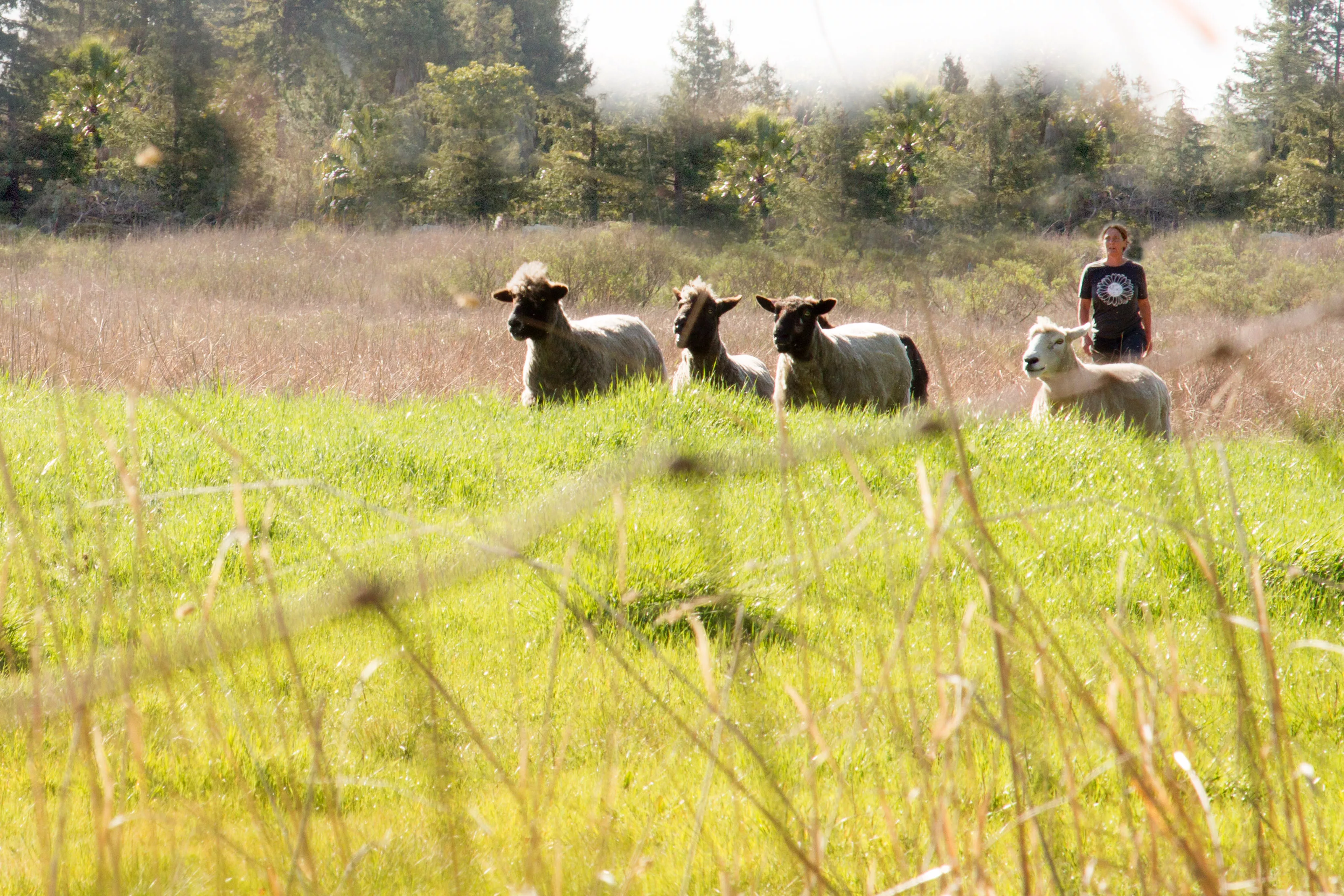
A neighbor watches over grazing sheep in the Hunter Grazing Coop near Santa Rosa. Neighborhood grazing coops have proven to be a cost-efficient way for neighborhoods to deal with fire fuels. [Photo courtesy of Hunter Grazing Coop]
Bucolic scenes of rolling hills with sheep lazily grazing is more than an iconic wine country vision. It’s a way of protecting that beautiful landscape from wildfires, while also making the land healthier and more drought tolerant.
As the threat of wildfire has increased—stirring anxiety among North Bay residents even before the devastating fires of 2017—grazing operations began popping up to help deal with the overgrown brush that serve as fuel to raging flames. Some residents with smaller properties have found that joining forces with their neighbors is a great way to keep the cost of grazing down.
Wild Oat Hollow and community grazing coops
Sarah Keiser of Wild Oat Hollow in Penngrove does land stewardship consulting and has been helping build community grazing cooperatives throughout Sonoma County. She’s helping communities become more fire resilient and connected as their land grows healthier.
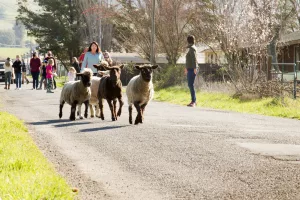
“That’s in my neighborhood with my sheep,” Keiser says. “There’s no economic give or take between any of us. We just share the sheep. Whoever has them on their plate gives them water and keeps an eye on them and enjoys them. They move around and do vegetation management and ecosystem services. We’re really watching the landscape change.”
The benefits of the grazing coops go far beyond the landscape—and Keiser first witnessed that in her own neighborhood. “Our community is taking care of each other, we know each other better,” she says. “Everybody loves the sheep. They just kind of are that global system of community connection, community resiliency and ecosystem services that move around the community.”
Keiser has helped establish 15 grazing cooperatives throughout the county. The individual grazing coops are set up according to the needs of each neighborhood, their landscape and what their goals are. “Some communities share a flock,” she says. “Some are nestled next to a rancher who brings the animals through that community in a shared relationship. Some of them come together and hire a contract grazer annually.”
The more acreage you have the less everybody pays per acre with the added benefit of the whole community becoming fire resilient.
Keiser’s work with the coops is funded by the Globetrotters Foundation. She works as a consultant with the Sonoma Resource Conservation District, to help with its landmark grazing projects and also advises the City of Petaluma on grazing.
“The City of Petaluma is really spearheading a new way forward for municipalities to utilize grazing in their vegetation management and to build up their native seed banks,” Keiser says. “They’re looking at a 5- to 10-year plan of ecological transformation through grazing to bring the landscape back to a healthy [fire-resistant] ecosystem and to increase carbon sequestration through sophisticated grazing methods.”
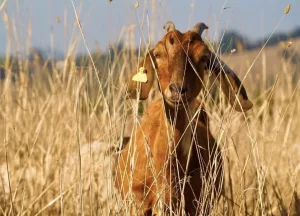
“Our plants have evolved over millennia with the impact of grazing ruminants and ungulates,” Keiser says. “They coevolved together. So we need to make sure that we’re understanding those two pieces actually go together very beautifully.”
Keiser says the key is how we humans manage them. “The indigenous people utilized the large herds of elk and deer,” she says. “They would just push them through or encourage them to different places to do grazing.”
Those who have embraced grazing for fire fuel reduction as a way to bring back a healthy landscape have inadvertently become stewards of the land through that good management.
Carbon sequestration occurs as photosynthesis when plants that have been grazed begin to grow again. It could be done with mechanized equipment taking down the tall grasses and then allowing the regrowth to happen, but Keiser points out that in that scenario an important component would be missing.
“The difference with animals is they’re digesting the grass, their hoof impact is aerating the soil and their manure and urine are adding organic matter back to the soil,” she says. “They’re not just removing vegetation for regrowth, they’re replacing and building the system.”
Keiser notes that a stockyard system is something completely different and detrimental to the land. When a lot of land is being used for growing grains and animals are then kept in a stockyard and fed those grains—all of that land is being depleted.
“That’s a broken system,” Keiser says. “What would be far better is if we actually had those animals on the land grazing around and building prairies and grasslands with deep root systems—not tilling the land for grain production. We’ve lost so much of our soil and a lot of our healthy systems through tilling soils.
“Where there are animals being put across the land and managed well, we see much more flourishing ecosystems, more land for birds and wildlife,” she says.

“Because we’ve created the space and the network for those seeds to come back and grow, our native seed bank can live up to 200 years in the soil,” she says. “They’re perennials, so there’s carbon sequestration happening year-round. They’re green year-round, and they have much more water retention that helps to create spongy soil. So our water goes down into the soil and not down the hill and into the river, taking a bunch of soil with it.”
Adds Keiser: “Resiliency isn’t just getting rid of vegetation. It’s thinking about an ecosystem that is fire resilient, absorbs water, is healthier and balanced so we can have healthy fires instead of devastating wildfires.”
Napa Pasture Protein
For those farmers who are providing grazing animals as a business, it’s also become a way to save the family farm.
Cori Carlson and her husband Casey own Napa Pasture Protein, a family farm incorporating holistic farming methods to ensure the health of its animals and the land. They also do consulting and education work to help others embrace these practices.
A big part of maintaining the health of their farm is by ensuring that it is as fire resilient as possible and grazing animals have been the key to that success.
Carlson says they realized after the 2017 wildfires that grazing was a great way to create a landscape that could deter flames. Areas around the farm that had been grazed survived while other areas burned. They’ve since added a grazing business into their farm’s operations and it’s helping to keep the farm going during challenging economic times.
“It’s very difficult to be profitable on a small scale in farming operations and the grazing has helped sustain the farm,” Carlson says. “That’s sort of the only part that has really sustained it.”
Without the grazing, their farm wouldn’t make it, she says. “I would be pretty much stuck with a lot of the conventional farming aspects that, in my opinion, monetarily are not sustainable, and which is why we’re seeing so many farms fall.”
She says she talks a lot about the ground when explaining holistic farming because that’s what you’re really looking for in your outcome. “When I run sheep across it, when I run cattle across it, that grass is going to save me some money on feed, and the more productive it is the less I’m having to input to get a finished product,” she says.
Carlson says they don’t overgraze any particular area. They section off areas and create high intensity grazing situations and then move the animals to another area. “That sort of mimics the herds of the grassland prairies from long ago,” she says. “That stimulates the root growth of the plant life.”
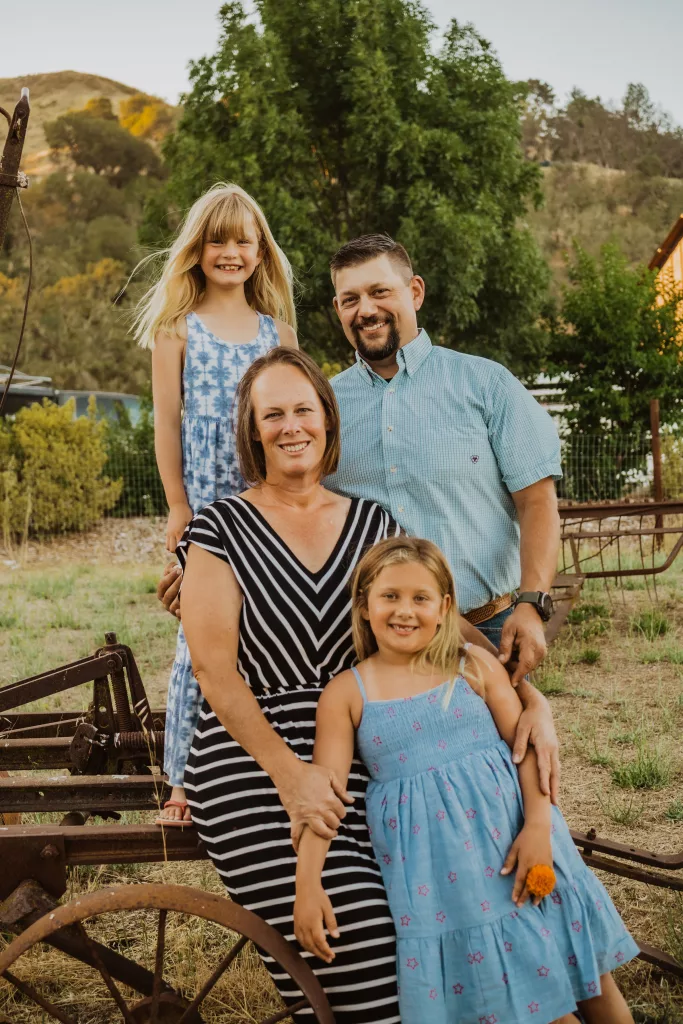
“A lot of times when we come in for a first-year client, they’ll have some really tall, noxious stickers and the wild oat is 6- to 8-feet tall—you can just tell it’s under grazed,” she says.
In this situation Carlson encourages them to seed it with native low-growing grasses after it has been grazed. She explains that flames can be three times the height of the grasses or even higher if the wind is pushing the flames.
“If you have a low-growing clover or an annual rye it might get 8-inches tall,” she says. “Triple that and you’re at 2 feet—that’s a manageable flame that we can deal with. But you get these wild oats, these mustards, these purple-headed thistle. They’re 8-feet tall sometimes, and you start looking at that and there’s no way to keep it from getting fire into the canopy.”
During the 2017 and 2020 wildfires they lost close to 80% of their oak trees in areas that hadn’t been grazed. Carlson says she’s hoping they can slow down the loss of the beautiful North Bay habitat through grazing and stresses the importance of the well-established native trees to the local ecosystem.
“Without those trees that ecosystem changes fast,” she says. “We’ll start looking a lot more like Southern California. It breaks my heart when an oak tree comes down, because you won’t see that size of an oak there again in your lifetime. It’s gone.”
The City of San Rafael grazing operations
In Marin County, the City of San Rafael has turned to grazing to mitigate fire fuels in city open space parcels.The City of Santa Rafael Fire Department took over the grazing program from the Department of Public Works after the passing of the county’s Measure C, a parcel tax which gives additional funding to fire agencies for wildfire mitigation. The fire department has been overseeing the program for four years.
“So we’ve been grazing,” says Calvin Schrader, a senior vegetation management specialist and master arborist working for the San Rafael Fire Department. “We’ve selected up to 99 sites, which total up to about 180 acres of vegetation, near homes and high-wildfire-risk areas. It’s being funded entirely through Measure C funding.”
Schrader says the rest of the city’s 1,000 acres of open space is either a mix of forested areas or areas that are deep chaparral and brush or environmentally sensitive. Grazing costs and budget constraints so far mean they need to stick to the acreage that is closer to residents.
“We’re actually performing some larger-scale vegetation work, in an area known as the San Rafael – San Anselmo Fuel Reduction Zone,” Schrader says. “In areas like that, we’re removing invasive plants. We’re removing invasive eucalyptus and broom. We plan on potentially using goats or other methods to remove those flashy fuels and maintain them.”
Schrader and his team consult with geologists, botanists and biologists to ensure the grazing is environmentally friendly and sustainable.
They’ve already seen a positive impact on the landscape during a fire. “One site that we have an ignition on pretty much every single year is San Rafael Hill, which is very close to central San Rafael,” he says. “So we graze that annually.”
Last year firefighters responded to a fire there. “When it reached that fuel break where the grazing had occurred, they were able to stop it and keep it to a fire that was less than five acres,” Schrader says.
“When they’re able to go there and do direct attack on these fires because they’re low intensity in these areas that have been grazed, they’re able to do it in a much safer way for the firefighters and prevent it from becoming a larger fire than it would have otherwise,” he says.
“These grasses in California historically have either been burned by the Coastal Miwok people here in San Rafael, or through natural circumstances over hundreds and hundreds of years,” Schrader says. “Only recently have we really stopped this fire regime for people to start living here. And with that, we’ve seen this increase in fuels and fuel loading.”
Schrader says that bringing grazing animals back to these areas is returning them to a more natural state. “We’re seeing less brush and more grasses, more annuals and more native species in these areas than we do in areas that are not grazed,” Schrader says. “There definitely are a lot of environmental benefits.”
Reducing the risk of more intense wildfires also helps avoid a scarred landscape and erosion. “Those hotter fires create areas where seeds can’t germinate because there isn’t any living bio underneath the soil,” he says. “By getting ahead of that, we’re actually creating a much healthier site in the event of a fire, because of that reduced intensity.”
There’s a scarcity of grazing operations in Marin County and so the city is currently working with businesses from outside the area. For those Marin County landowners who are interested in having grazing done, we spoke with one Sonoma County grazing operation that will travel to them.
Chasin Goat Grazing in Sonoma and Marin
Chase Cianfichi and his wife Emma own Chasin Goat Grazing. “We’re happy to come take a look at any property over there and we give free estimates,” Cianfichi says.
We spoke with him about all that goes into a grazing business. “It’s definitely like a new business idea,” Cianfichi says. “The practice has been around forever, but the idea of being paid for grazing and that whole concept is something new. Business definitely has been good.”
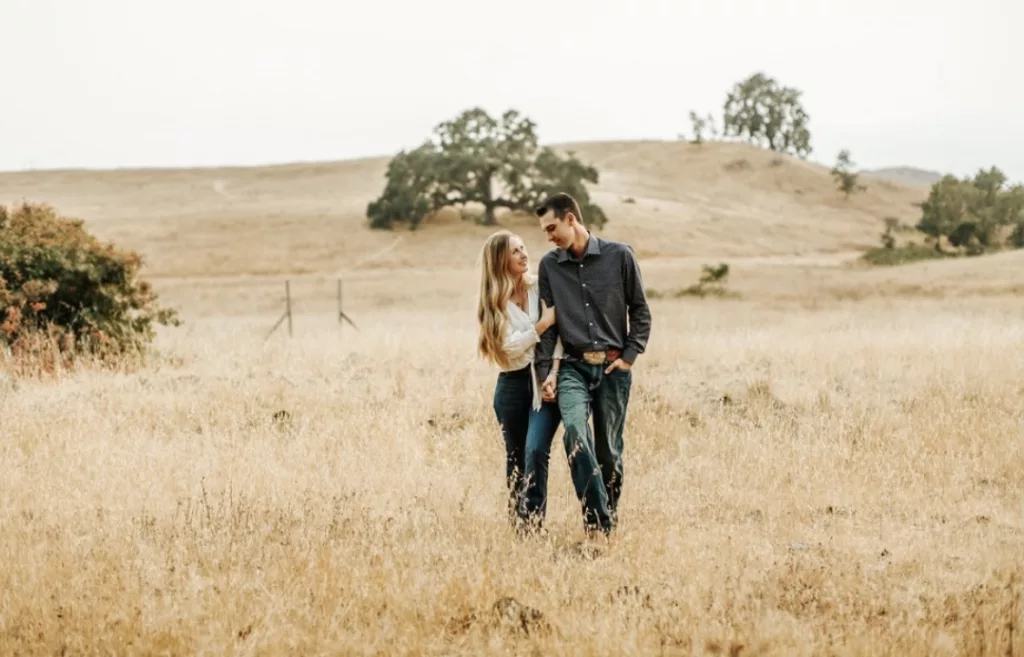
Besides livestock expenses, like feed and vaccinations, they maintain equipment like fencing and vehicles, and have hauling expenses and permits. They have employees who stay on site with the animals and watch over them. “Our guys are on work visas, and so you pay a monthly salary, plus their housing and the food allowance,” Cianfichi says.
Even with such overhead, business has been good. “We’re profitable, and it’s looking up right now,” Cianfichi says.
There’s an ever-increasing demand from landowners hoping to create a fire-resilient landscape, and operations like Chasin Goat Grazing make it easy by being mostly self-contained operations.
“We need access to water, that’s the big thing,” Cianfichi says. “We’ll supply the transportation, the fencing, the person to watch the animals and the water troughs. If we need a water wagon, we’ll bring a four-wheeler that pulls a little water wagon behind it.”
They’ve been working on around 110 properties a year with the average-size parcel around 30 acres. Cianfichi says they’ve done 200-acre jobs and they can handle even bigger parcels than that.
Cianfichi says they’ll work on pretty much any size parcel, although they do have a 1-acre minimum. “We’ll do smaller parcels, but we just charge a 1-acre minimum fee,” he says. That makes it pricey and so they encourage people with under an acre to consider asking neighbors if they might want to have their property grazed as well.
Cianfichi says that one reason the business runs smoothly is because of his wife Emma’s work in the office. “She makes sure we’re staying on track and keeps us organized,” he says.
He’s also thankful for the guys who return year after year on work visas to help take care of the herd. “They’re awesome and definitely make it possible to be able to do this,” he says.



